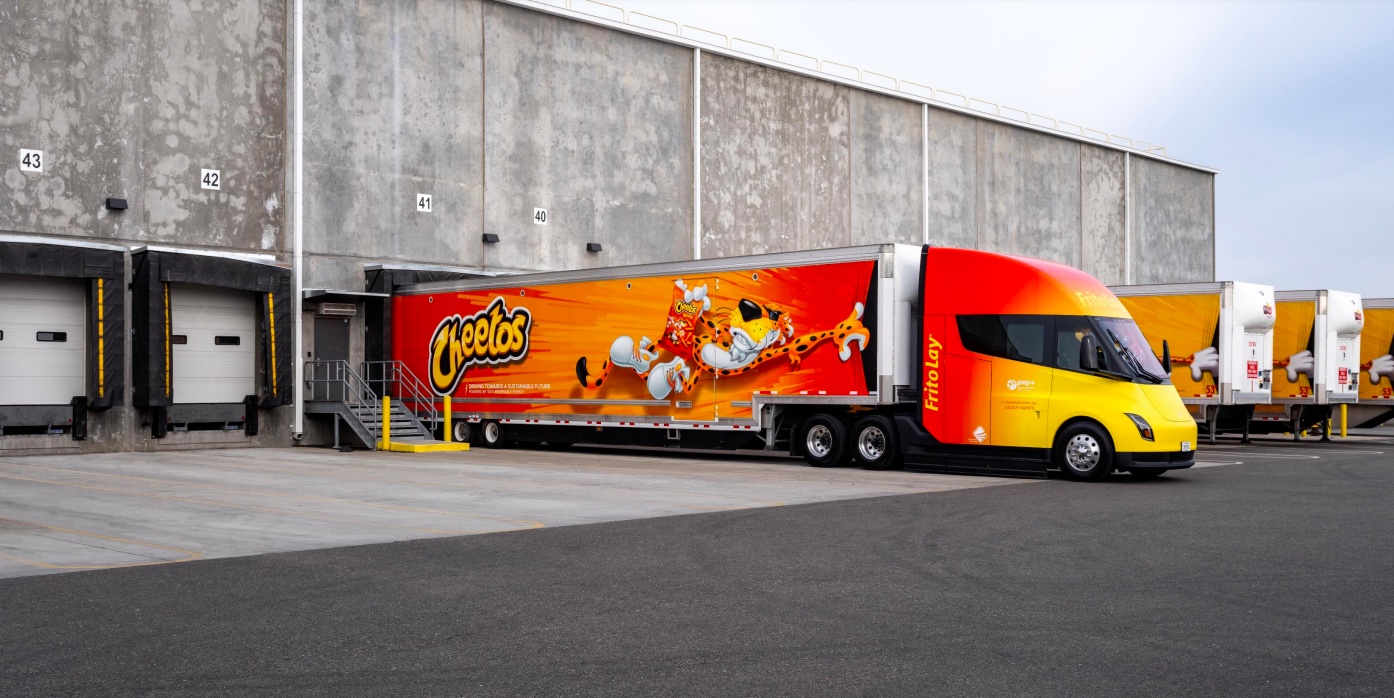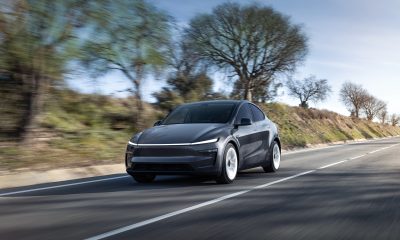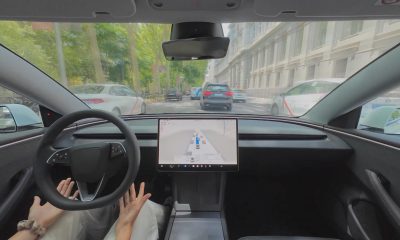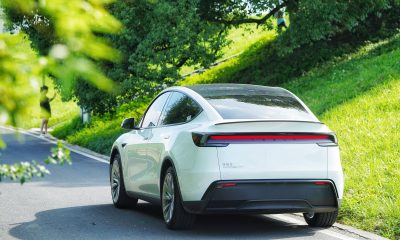

News
Tesla Semi production specs: powertrain, battery, Megacharger output, and more
The Tesla Semi has already been delivered to its first customers, but the actual production specs of the vehicle remain largely unknown or unconfirmed at best. Fortunately, a recent trip to PepsiCo’s Frito Lay facility in Modesto, Caifornia has provided some details that otherwise reveal the Tesla Semi production specs.
When Tesla held the first deliveries of the Semi, CEO Elon Musk highlighted that sustainable long-haulers are needed because in the transportation sector, semi trucks comprise about just 1% of vehicles on the road but they account for 20% of the emissions. Vehicles like the Tesla Semi are then designed to challenge this status quo.
Automotive publication MotorTrend was able to visit PepsiCo’s Modesto Frito Lay facility to check out the company’s first Tesla Semi units. As noted by the publication, the Modesto facility is a perfect fit for the Semi as the site already uses other green vehicles like BYD 8Y yard tractors, Peterbilt 220EV electric box trucks, and natural-gas-powered Volvo VNL trucks. The Tesla Semi fleet is used for out-and-back trips across the region.
The publication was able to gather some details about the Class 8 all-electric truck from its drivers and Tesla representatives who were at the location during the visit. Following are some key specs of the Tesla Semi.
Powertrain
The Tesla Semi features a modified Plaid tri-motor powertrain that’s spun backward. The Model S’ front motor drives the Semi’s rear axle and acts as the vehicle’s high-efficiency “highway drive unit.” The Model S Plaid’s dual rear motors, on the other hand, are installed on the rear axle. With this in mind, MotorTrend estimated that the Tesla Semi likely matches the Model S and Model X Plaid’s 1,020 horsepower and 1,050 pounds-feet of torque.
This estimate makes sense considering that a Tesla representative reportedly noted that the Tesla Semi makes “three times the power of an average diesel semi.” The US’ best-selling semi is the Freightliner Cascadia, whose base model features 350 horsepower. Three times the base Cascadia’s horsepower certainly aligns with the estimate that the Semi has about 1,020 horsepower. On a side note, the Tesla Semi production version does not have a frunk, unlike the vehicle’s prototype units.
Battery
Drivers of the Tesla Semi reportedly noted that the all-electric Class 8 truck is fitted with a 1,000 kWh battery pack. Tesla lists the Semi’s range as 500 miles per charge, and Elon Musk has also highlighted that the vehicle would consume only 2 kW per mile traveled.
If these estimates prove accurate, then the Semi’s 300-mile variant would likely have a battery pack that’s around 600 kWh. That’s still a lot of batteries, so Tesla would have to ensure that its production is optimized to ensure that the Semi is profitable.
Megacharger Output
The Tesla Semi features a charging port that’s different from all the vehicles that the company has released so far. The motoring publication noted that the Tesla Semi’s Megachargers installed on the Modesto facility could provide around 750 kW of power, or about three times the output of the company’s Supercharger V3 network.
The cables for the Tesla Semi’s Megachargers are thick, though they are reportedly easy to manage compared to some DC fast charging networks in the market. Charging the Semi from almost empty to 70% typically takes about 30 minutes. A full charge all the way to 100% reportedly takes around 90 minutes.
Physical Controls
While the Tesla Semi’s controls are mostly centered on its two infotainment systems, the vehicle also sports several physical buttons. Among these are the parking brake, trailer-brake air supply, and the vehicle’s hazards. Other physical controls include stalks similar to those found in the Tesla Model 3 and Model Y, though some buttons on the steering wheel resemble those in the new Model S and Model X.
Interior Space
The cabin of the Tesla Semi is cavernous, similar to the company’s other vehicles. MotorTrend noted that there’s enough space to enable a six-foot person to walk around and stretch in the Tesla Semi’s 3×7 foot cabin. So far, PepsiCo’s drivers seem to like the Semi, with some telling the motoring publication that the all-electric truck was very comfortable and “drove like a car.”
Other Details
The use of the Tesla Semi’s dual infotainment systems is quite interesting. The right display functions as the Tesla Semi’s main infotainment unit, while the left display exclusively shows pertinent information about the truck, such as its tire pressure. The windows in the Semi’s cabin also open when needed, though they do not roll down. Some space in the cabin also seem to be reserved for customers who wish to order the Tesla Semi with a sleeper cabin. Images taken of the Semi’s displays also confirm that the vehicle is equipped with Tesla’s Full Self-Driving computer.
Don’t hesitate to contact us with news tips. Just send a message to simon@teslarati.com to give us a heads up.
News
Tesla UK sales see 14% year-over-year rebound in June: SMMT data
The SMMT stated that Tesla sales grew 14% year-over-year to 7,719 units in June 2025.

Tesla’s sales in the United Kingdom rose in June, climbing 14% year-over-year to 7,719 units, as per data from the Society of Motor Manufacturers and Traders (SMMT). The spike in the company’s sales coincided with the first deliveries of the updated Model Y last month.
Model Y deliveries support Tesla’s UK recovery
Tesla’s June performance marked one of its strongest months in the UK so far this year, with new Model Y deliveries contributing significantly to the company’s momentum.
While the SMMT listed Tesla with 7,719 deliveries in June, independent data from New AutoMotive suggested that the electric vehicle maker registered 7,891 units during the month instead. However, year-to-date figures for Tesla remain 2% down compared to 2024, as per a report from Reuters.
While Tesla made a strong showing in June, rivals are also growing. Chinese automaker BYD saw UK sales rise nearly fourfold to 2,498 units, while Ford posted the highest EV growth among major automakers, with a more than fourfold increase in the first half of 2025.
Overall, the UK’s battery electric vehicle (BEV) demand surged 39% to to 47,354 units last month, helping push total new car sales in the UK to 191,316 units, up 6.7% from the same period in 2024.
EV adoption accelerates, but concerns linger
June marked the best month for UK car sales since 2019, though the SMMT cautioned that growth in the electric vehicle sector remains heavily dependent on discounting and support programs. Still, one in four new vehicle buyers in June chose a battery electric vehicle.
SMMT Chief Executive Mike Hawes noted that despite strong BEV demand, sales levels are still below regulatory targets. “Further growth in sales, and the sector will rely on increased and improved charging facilities to boost mainstream electric vehicle adoption,” Hawes stated.
Also taking effect this week was a new US-UK trade deal, which lowers tariffs on UK car exports to the United States from 27.5% to 10%. The agreement could benefit UK-based EV producers aiming to expand across the country.
News
Tesla Model 3 ranks as the safest new car in Europe for 2025, per Euro NCAP tests
Despite being on the market longer than many of its rivals, the Tesla Model 3 continues to set the bar for vehicle safety.

The Tesla Model 3 has been named the safest new car on sale in 2025, according to the latest results from the Euro NCAP. Among 20 newly tested vehicles, the Model 3 emerged at the top of the list, scoring an impressive 359 out of 400 possible points across all major safety categories.
Tesla Model 3’s safety systems
Despite being on the market longer than many of its rivals, the Tesla Model 3 continues to set the bar for vehicle safety. Under Euro NCAP’s stricter 2025 testing protocols, the electric sedan earned 90% for adult occupant protection, 93% for child occupant protection, 89% for pedestrian protection, and 87% for its Safety Assist systems.
The updated Model 3 received particular praise for its advanced driver assistance features, including Tesla’s autonomous emergency braking (AEB) system, which performed well across various test scenarios. Its Intelligent Speed Assistance and child presence detection system were cited as noteworthy features as well, as per a WhatCar report.
Other notable safety features include the Model 3’s pedestrian-friendly pop-up hood and robust crash protection for both front and side collisions. Euro NCAP also highlighted the Model 3’s ability to detect vulnerable road users during complex maneuvers, such as turning across oncoming traffic.
Euro NCAP’s Autopilot caution
While the Model 3’s safety scores were impressive across the board, Euro NCAP did raise concerns about driver expectations of Tesla’s Autopilot system. The organization warned that some owners may overestimate the system’s capabilities, potentially leading to misuse or inattention behind the wheel. Even so, the Model 3 remained the highest-scoring vehicle tested under Euro NCAP’s updated criteria this year.
The Euro NCAP’s concerns are also quite interesting because Tesla’s Full Self-Driving (FSD) Supervised, which is arguably the company’s most robust safety suite, is not allowed for public rollout in Europe yet. FSD Supervised would allow the Model 3 to navigate inner city streets with only minimal human supervision.
Other top scorers included the Volkswagen ID.7, Polestar 3, and Geely EX5, but none matched the Model 3’s total score or consistency across categories. A total of 14 out of 20 newly tested cars earned five stars, while several models, including the Kia EV3, MG ZS, and Renault 5, fell short of the top rating.
Elon Musk
Why Tesla’s Q3 could be one of its biggest quarters in history
Tesla could stand to benefit from the removal of the $7,500 EV tax credit at the end of Q3.

Tesla has gotten off to a slow start in 2025, as the first half of the year has not been one to remember from a delivery perspective.
However, Q3 could end up being one of the best the company has had in history, with the United States potentially being a major contributor to what might reverse a slow start to the year.
Earlier today, the United States’ House of Representatives officially passed President Trump’s “Big Beautiful Bill,” after it made its way through the Senate earlier this week. The bill will head to President Trump, as he looks to sign it before his July 4 deadline.
The Bill will effectively bring closure to the $7,500 EV tax credit, which will end on September 30, 2025. This means, over the next three months in the United States, those who are looking to buy an EV will have their last chance to take advantage of the credit. EVs will then be, for most people, $7,500 more expensive, in essence.
The tax credit is available to any single filer who makes under $150,000 per year, $225,000 a year to a head of household, and $300,000 to couples filing jointly.
Ending the tax credit was expected with the Trump administration, as his policies have leaned significantly toward reliance on fossil fuels, ending what he calls an “EV mandate.” He has used this phrase several times in disagreements with Tesla CEO Elon Musk.
Nevertheless, those who have been on the fence about buying a Tesla, or any EV, for that matter, will have some decisions to make in the next three months. While all companies will stand to benefit from this time crunch, Tesla could be the true winner because of its sheer volume.
If things are done correctly, meaning if Tesla can also offer incentives like 0% APR, special pricing on leasing or financing, or other advantages (like free Red, White, and Blue for a short period of time in celebration of Independence Day), it could see some real volume in sales this quarter.
You can now buy a Tesla in Red, White, and Blue for free until July 14 https://t.co/iAwhaRFOH0
— TESLARATI (@Teslarati) July 3, 2025
Tesla is just a shade under 721,000 deliveries for the year, so it’s on pace for roughly 1.4 million for 2025. This would be a decrease from the 1.8 million cars it delivered in each of the last two years. Traditionally, the second half of the year has produced Tesla’s strongest quarters. Its top three quarters in terms of deliveries are Q4 2024 with 495,570 vehicles, Q4 2023 with 484,507 vehicles, and Q3 2024 with 462,890 vehicles.
-

 Elon Musk4 days ago
Elon Musk4 days agoTesla investors will be shocked by Jim Cramer’s latest assessment
-

 News1 week ago
News1 week agoTesla Robotaxi’s biggest challenge seems to be this one thing
-

 Elon Musk2 weeks ago
Elon Musk2 weeks agoFirst Look at Tesla’s Robotaxi App: features, design, and more
-

 News2 weeks ago
News2 weeks agoSpaceX and Elon Musk share insights on Starship Ship 36’s RUD
-

 News2 weeks ago
News2 weeks agoWatch Tesla’s first driverless public Robotaxi rides in Texas
-

 News1 week ago
News1 week agoWatch the first true Tesla Robotaxi intervention by safety monitor
-

 News2 weeks ago
News2 weeks agoTesla has started rolling out initial round of Robotaxi invites
-

 Elon Musk2 weeks ago
Elon Musk2 weeks agoTesla to launch in India in July with vehicles already arriving: report

















